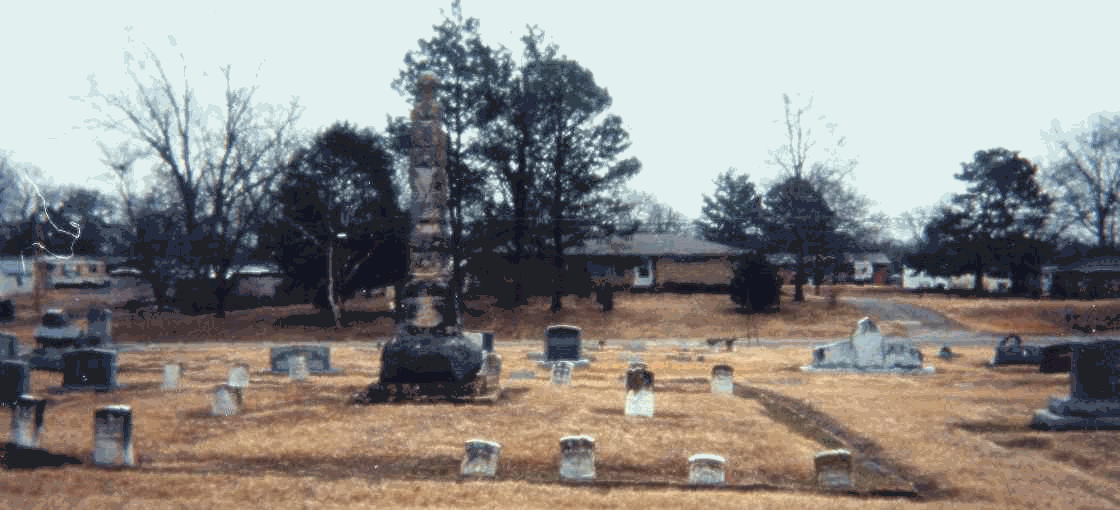

Caring for Evergreen Is Peaceful Work
By SUSAN McADAMS
Arkansas Democrat-Gazette, August 19, 2001
How does one mow a cemetery, anyway? For Samuel Crawford, who has been caretaker of Evergreen Cemetery in Judsonia for 18 years, mowing one section at a time and changing the routine once in awhile makes it easy.
"It doesn’t seem like it has been that long," Crawford said softly during one of his visits to the 10-acre cemetery. He then laughed, though, and added the work is easier than when he first started because the city bought him a new tractor to ride.
Crawford drove a school bus for 25 years and was in the National Guard for 40. At 72, the mowing season that begins in April each year now keeps him busy. He mows three to four days of each week, doing nothing special to keep the grass green and using herbicide around headstones where mowing is difficult. When bare spots appear, a little Zoysia grass seed is planted.
Evergreen Cemetery opened in the mid-1800s and the names of many long-time area families can be seen on the headstones. Pointing at one, Crawford said he remembers his father talking about working for the man buried there. Another man in eternal rest nearby hunted and fished with his father. Other graves hold older residents who took more interest in keeping graves pretty when alive.
"Some of the younger people do that, but not like the other people did," Crawford said.
Different thoughts come to him when mowing. "I always wonder if they were ready to go, if they were ready to meet the Lord," he said about the deceased. That is especially true for the many soldiers buried there. Crawford knelt beside a small white stone covered with lichen and read the worn inscription: "Spanish American War." Other details include "Co G" and "2 Ark Inf" for Company G and Second Arkansas Infantry. The older stones are heavier than they look and are possibly made of marble, he says.
Nearby is another very old marker where a sergeant in the Confederate State Army is buried. A child who lived only from 1877-1881 and has the same name is buried next to him.
The most unusual marker in the cemetery sits close to the road and is actually a monument. It is so unique, Crawford said, town leaders have talked about applying for a grant to put a light and flagpole at the site. The monument was listed in the National Historic Register years ago.
What little is known about the monument was noted by W. E. Orr in That’s Judsonia, written in 1957. Four senior Girl Scouts who created a reference booklet on the cemetery in 1999 as a community service project listed additional details.
Surrounding it are 16 markers with the names of infantry soldiers from Illinois, Ohio, Tennessee or Indiana. A star and eagle decorate one side and a cannon ball is on top.
The historical information notes how the 16 soldiers were buried around the monument after it was erected. They were said to have not been killed in action, but rather were men who were in White County after the war and were without families or burial plots.
A news report of the monument dedication says it was the only Grand Army of the Republic memorial south of the Mason-Dixon line at the time. It was purchased by the Judsonia G.A.R., which made sure children of both Union and Confederate soldiers attended the dedication. It is not known why the grave of a World War II veteran is located in the middle of the 16 Civil War graves.
Looking around, Crawford pointed out other distinct markers he has become familiar with. One family plot had several children that died within years of each other. Years ago, it wasn’t uncommon for children to die young, he said.
One section of the cemetery was opened after the tornado that destroyed thriving downtown Judsonia and the lives of many people. Graves there indicate March 21, 1952, as the date of death. The tornado hit while young people of the town were getting ready for the prom to be held that night. Crawford said there also are many graves in Evergreen of people who died in the flu epidemic of 1918. He reached down to pick up a small branch left over from the winter ice storm, saying, "The trees are pretty, but messy.
"The cemetery board, led by C. W. Mangrum, and the city have been good to me here. I told them I wanted to take care of the cemetery by myself.
And that he has done, mostly. City leaders sent assistance for picking up tree limbs after the ice storm and see that equipment is taken care of at the city shop.
Cleaning up flowers after a storm is a big part of the caretaker’s job. So sometimes he lets them lay for family members to return them to their respective sites before discarding them.
Crawford prefers the flower saddles that attach to the top of a headstone. Experience has shown him that flowers in containers sometimes float out when the container fills with rainwater, and the stands blow away easily, he explained.
"I enjoy working out here. People tell me almost daily that I do a good job, and it makes me feel good," he said. "Then there are some who don’t even know someone takes care of the cemetery."